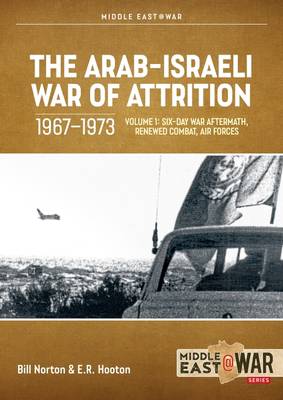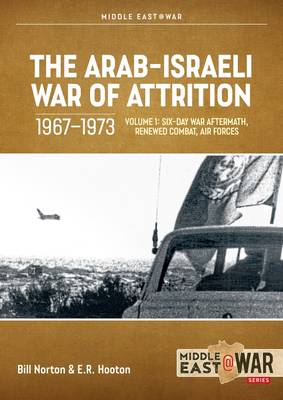
- Retrait gratuit dans votre magasin Club
- 7.000.000 titres dans notre catalogue
- Payer en toute sécurité
- Toujours un magasin près de chez vous
- Retrait gratuit dans votre magasin Club
- 7.000.0000 titres dans notre catalogue
- Payer en toute sécurité
- Toujours un magasin près de chez vous
The Arab-Israeli War of Attrition, 1967-1973
Volume 1: Six-Day War Aftermath, Renewed Combat, Air Forces
Bill Norton, E R Hooton
27,95 €
+ 55 points
Format
Description
"...this work is packed with information and should appeal to anyone with an interest in the history of conflict between Israel and its neighbors." -- The Journal of the Air Force Historical Foundation
The Arab-Israeli conflict persisted through two wars and ongoing border tensions. However, the Six-Day War of June 1967 was a cataclysm. Israel emerged victorious in a war with neighboring Arab states and in possession of occupied territory. The Arabs were furious at this outcome and determined to regain their lands and dignity by again making war with Israel. Added to the mix was a resurgent Palestinian liberation movement. Renewed fighting began within weeks. It became a period of sustained combat, casualties, fiscal outlay, and diplomacy on the world stage unlike anything experienced previously. All involved militaries remained very active over these years with more consistent mobilization, intensive training, and action than ever before. Each side deepened their dependence on superpower arms supply. The geopolitical stakes rose and Israel found itself fighting the Soviets indirectly on the borders and terrorist internationally. Adversary forces grew in size, adopted more complex weapons, and trained in new tactics, all in the tumult of combat of escalating intensity. The danger of this sparking another general war with potential superpower involvement was high. This period is collectively referred to as the War of Attrition.
The named War of Attrition on the Suez Canal was began on March 8, 1969, and ended with a ceasefire 17 months later. However, there was combat on all fronts before and after. Palestinian irregulars operating from Jordan brought Israeli counter-insurgency operations in the West Bank and Jordan. Israeli special operations and bombing inside Jordan sought to compel that government to reign in the guerrillas and this greatly threatened the economy. The Palestinian elements challenged the Jordanian government itself and a civil war erupted that saw a dramatic decline in the power of the irregulars. Moving their principal base of operations to Lebanon saw the same cycle began evolving there. Syria struggled to regain strength to take on Israel again. They eventually began periodic operations against Israeli forces on the Golan Heights as retribution and to build strength for the next war many saw as inevitable.
The air forces of especially Israel and Egypt, then Syria, became especially active, grew in size and capabilities. They employed some of the most advanced weapons the USA and the USSR arrayed in their Cold War confrontation. The extent of the air war grew to extensive air defenses and long-range bombing plus deep photo reconnaissance.
It was an extraordinary time of confrontation, irregular warfare, rising terrorism, and national struggles seldom seen before or since. It became the world's most violent, costly, and dangerous conflict after that in Southeast Asia. At the center of it, Israel found herself engaged on all sides and isolated as never before. The struggle altered the geopolitical landscape and set the stage for the October 1973 war.
Volume 1 of this series covers the immediate aftermath of the Six-Day War as forces were reconstituted, strategies formulated and combat began anew on the new borders. The air forces and associated weapons that would play a significant role in the coming years are detailed.
The Arab-Israeli conflict persisted through two wars and ongoing border tensions. However, the Six-Day War of June 1967 was a cataclysm. Israel emerged victorious in a war with neighboring Arab states and in possession of occupied territory. The Arabs were furious at this outcome and determined to regain their lands and dignity by again making war with Israel. Added to the mix was a resurgent Palestinian liberation movement. Renewed fighting began within weeks. It became a period of sustained combat, casualties, fiscal outlay, and diplomacy on the world stage unlike anything experienced previously. All involved militaries remained very active over these years with more consistent mobilization, intensive training, and action than ever before. Each side deepened their dependence on superpower arms supply. The geopolitical stakes rose and Israel found itself fighting the Soviets indirectly on the borders and terrorist internationally. Adversary forces grew in size, adopted more complex weapons, and trained in new tactics, all in the tumult of combat of escalating intensity. The danger of this sparking another general war with potential superpower involvement was high. This period is collectively referred to as the War of Attrition.
The named War of Attrition on the Suez Canal was began on March 8, 1969, and ended with a ceasefire 17 months later. However, there was combat on all fronts before and after. Palestinian irregulars operating from Jordan brought Israeli counter-insurgency operations in the West Bank and Jordan. Israeli special operations and bombing inside Jordan sought to compel that government to reign in the guerrillas and this greatly threatened the economy. The Palestinian elements challenged the Jordanian government itself and a civil war erupted that saw a dramatic decline in the power of the irregulars. Moving their principal base of operations to Lebanon saw the same cycle began evolving there. Syria struggled to regain strength to take on Israel again. They eventually began periodic operations against Israeli forces on the Golan Heights as retribution and to build strength for the next war many saw as inevitable.
The air forces of especially Israel and Egypt, then Syria, became especially active, grew in size and capabilities. They employed some of the most advanced weapons the USA and the USSR arrayed in their Cold War confrontation. The extent of the air war grew to extensive air defenses and long-range bombing plus deep photo reconnaissance.
It was an extraordinary time of confrontation, irregular warfare, rising terrorism, and national struggles seldom seen before or since. It became the world's most violent, costly, and dangerous conflict after that in Southeast Asia. At the center of it, Israel found herself engaged on all sides and isolated as never before. The struggle altered the geopolitical landscape and set the stage for the October 1973 war.
Volume 1 of this series covers the immediate aftermath of the Six-Day War as forces were reconstituted, strategies formulated and combat began anew on the new borders. The air forces and associated weapons that would play a significant role in the coming years are detailed.
Spécifications
Parties prenantes
- Auteur(s) :
- Editeur:
Contenu
- Nombre de pages :
- 104
- Langue:
- Anglais
- Collection :
Caractéristiques
- EAN:
- 9781804512258
- Date de parution :
- 03-03-23
- Format:
- Livre broché
- Format numérique:
- Trade paperback (VS)
- Dimensions :
- 211 mm x 288 mm
- Poids :
- 367 g

Les avis
Nous publions uniquement les avis qui respectent les conditions requises. Consultez nos conditions pour les avis.






